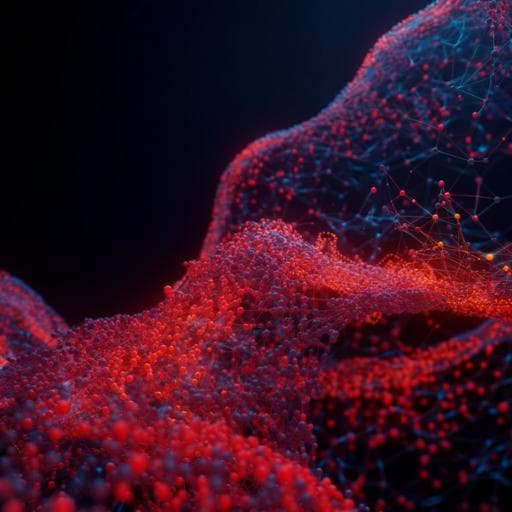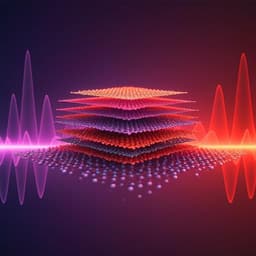
Engineering and Technology
Ubiquitous organic molecule-based free-standing nanowires with ultra-high aspect ratios
K. Kamiya, K. Kayama, et al.
Discover groundbreaking research by Koshi Kamiya and colleagues from Kyoto University and the Takasaki Advanced Radiation Research Institute, where a novel technique using high-energy charged particles has led to the production of free-standing 1D organic nanostructures with incredibly high aspect ratios. This innovative approach promises significant advancements in semiconductor device integration and functionality.
~3 min • Beginner • English
Introduction
The study addresses how to fabricate vertically aligned, free-standing organic nanowire arrays with ultrahigh aspect ratios and controlled parameters (length, diameter, density). Conventional approaches (top-down lithography, bottom-up epitaxy for inorganics; AAO templating; polymer lithography; organic crystal growth) face limitations: contamination by other nanostructures, limited aspect ratio or diameter control, and collapse upon template removal. The authors propose a method termed single particle-triggered linear polymerization (STLiP), wherein high-energy charged particles traverse organic thin films, initiating polymerization and cross-linking along straight ion tracks to form nanowires. A key challenge is isolating nanowires without collapse; the authors introduce an all-dry sublimation development that avoids solvent-induced pattern collapse. The work aims to demonstrate generality across many sublimable organic molecules, precise control over nanowire dimensions and density, three-dimensional alignment control, and integration of longitudinal and coaxial heterojunctions, alongside preliminary electrical and surface functional properties.
Literature Review
- Inorganic standing nanowire arrays have been fabricated via top-down lithography and bottom-up epitaxial growth (e.g., Si nanowires, VA-CNTs), enabling applications like black absorbers and adhesives but focusing on hard materials.
- Organic standing nanowires via bottom-up crystalline growth suffer from low structural purity, limited tunability of aspect ratios, and relatively large diameters (hundreds of nm). Polymer-based lithographic pillars achieve only modest aspect ratios (~10).
- AAO templating allows growth of organic nanowires (~50 nm minimum diameter) but wires fall over after wet template removal, yielding in-plane orientation.
- Wet development in nanofabrication induces pattern collapse due to capillary forces; supercritical fluids can mitigate but uniform high-aspect-ratio isolation remains difficult.
- Previous STLiP studies showed formation of nanowires from small molecules via high-energy particle-induced polymerization/cross-linking; halogenated aromatics enhance efficiency via dissociative electron attachment.
- Heterointerface designs (coaxial and segmented) in nanowires have been realized largely via templates or epitaxial methods in inorganic-inorganic, organic-inorganic, and organic-organic systems, with limited material choices. The present work seeks to broaden this for organic systems using standing nanowire platforms.
Methodology
Overview of STLiP process: High-energy heavy ions (e.g., 490 MeV Os30+, 350/450 MeV Xe23+/26+, 120 MeV Au9+) are irradiated orthogonally onto vapor-deposited or spin-coated organic films under high vacuum. Along straight ion tracks, energy deposition (LET) generates radicals and intermediates, inducing localized polymerization/cross-linking to form latent 1D gels (nanowires). Isolation is achieved by an all-dry sublimation process under vacuum that removes unreacted sublimable molecules, leaving polymerized nanowires standing. This avoids solvent-induced collapse.
Materials and film prep: Sublimable aromatic small molecules used include C60, C70, PC61BM, BPEA, TBPB, TBP, DBBA, HBT, PTCDA-Cl4, TiOPc, CuPc; 2,2′-bithiophene for electropolymerization. Films were deposited on cleaned Si (and ITO-glass for some experiments) by vacuum thermal evaporation (~10−4 Pa, 0.2–0.8 Å/s) with thicknesses from ~200 nm to 2500 nm (up to 2000 nm stated; examples include 250–2500 nm). PC61BM films were also spin-coated.
Irradiation: Ion beams delivered in vacuum (<1×10−4 Pa); fluence controlled from 1×10^9 to 1×10^12 cm−2 via exposure time and beam current. Straight trajectories in organics were confirmed by SRIM simulations, supporting wire lengths up to tens of micrometers theoretically.
Development/isolation: Post-irradiation, films were either (a) immersed in organic solvents (wet develop) or (b) sublimed under vacuum (5–8×10−3 Pa) by heating; sublimation end judged by optical reflectance change. Dry sublimation eliminates solvent surface tension and preserves verticality.
Characterization: SEM and AFM for morphology; parameters extracted included cross-sectional radius r (from AFM half-width/height via an ellipsoidal model), rigidity D/L (end-to-end over length from knocked-down wires made at low fluence 10^9–10^10 cm−2), coverage factor CNWs (fractional area), and height ratio HNWs/Tfilm. Raman spectroscopy verified chemical signatures of segments. Electrical measurements: two-probe DC vertical conductivity on C60 nanowire plexus between Au bottom and Ag paste top electrodes; conductive AFM for coaxial PT@C60. Water contact angles assessed for surface wettability.
Heterojunction formation: Longitudinal segmented (block-co-nanowire) heterojunctions fabricated by irradiating bilayer organic films (e.g., TiOPc/C60; PTCDA-Cl4/HBT) and isolating by stepwise sublimation tuned by temperature and vacuum. Coaxial heterostructures produced by electropolymerization of 2,2′-bithiophene in nitrobenzene with tetrabutylammonium tetrafluoroborate, using nanowire-coated ITO as anode (0.5 mA for 1 min, dedoping by reverse current), yielding polythiophene coats (PT@C60, PT@PTCDA-Clx) preferentially on wire surfaces.
Modeling/analysis: LET-based framework used to relate energy deposition p(r) to polymerization efficiency; derived a G(x) expression depending on density and molecular weight. G values estimated for various molecules; Poisson statistics used to estimate ion-track overlap (ensuring uniformity at typical fluences ~1×10^11 cm−2). Tilted irradiation and substrate rotation enabled 3D wire networks.
Key Findings
- All-dry sublimation isolation yields vertically aligned, free-standing organic nanowire arrays without collapse, with controllable length matching initial film thickness and high number density (~1×10^11 cm−2). Wet development leads to knocked-down, aggregated wires due to solvent surface tension.
- Aspect ratios: Standing nanowires maintained verticality up to at least 2500 nm length in C60 films (aspect ratio >300 for ~8 nm diameter wires). DBBA-based wires achieved aspect ratio >100. Cross-sectional radii typically ~5–6.6 nm (Table 1: C60 6.6±0.6 nm; BPEA 5.0±0.4; TBPB 4.9±0.4; TBP 5.3±0.5; DBBA 6.1±0.6; HBT 6.1±0.4; PTCDA-Cl4 6.1±0.3).
- Material generality: Successful standing nanowires formed from multiple sublimable aromatics: C60, C70 (with reduced verticality), BPEA, TBPB, TBP, DBBA, HBT, PTCDA-Cl4. PC61BM produced wires but suffered deformation in the dry process due to melting (~280 °C) below sublimation conditions (~300 °C), highlighting the need for sublimation below melting.
- Reaction efficiency: LET-based analysis gave G values indicating higher polymerization efficiency for C60 vs C70. Estimated G for C60 and C70 were ~35.1 and ~15.3 per 100 eV, consistent with ~3× higher reported photochemical efficiency in C60. Table 1 lists G values for other aromatics (e.g., DBBA 47, HBT 42, PTCDA-Cl4 43 per 100 eV), correlating with wire robustness and radius.
- Structural metrics: Rigidity D/L approached ~1 across materials (e.g., C60 0.97±0.03), indicating stiff wires. At 1×10^11 cm−2 fluence, Poisson-estimated overlap CNWs ~10–13% ensures uniform arrays. Height ratios HNWs/Tfilm varied (e.g., C60 ~0.97±0.03; BPEA ~0.59±0.11), with partial leaning due to inter-wire interactions; larger radii help maintain verticality. Low fluence (≤5×10^10 cm−2) reduced vertical alignment, underscoring the role of inter-wire interactions for standing arrays.
- 3D architectures: Tilted irradiation (e.g., θ=45°) and substrate rotation produced conical distributions and cross-connected 3D nanowire networks.
- Heterojunctions: Longitudinal segmented p–n nanowires realized from bilayers (e.g., C60/TiOPc; PTCDA-Cl4/HBT) with segment lengths matching layer thickness and preserved molecular signatures by Raman. Multi-segment wires demonstrated using C60/CuPc multilayers. Coaxial heterojunctions achieved by electropolymerizing polythiophene around C60 and PTCDA-Clx wires, increasing diameters while preserving lengths.
- Functional properties: Vertically aligned arrays facilitated device-like testing. Water repellency improved due to uniform vertical nanowires. DC conductivity in C60 nanowire plexus scaled approximately linearly with wire number density and top electrode area, suggesting uniform vertical conduction. p–n heterojunction nanowires exhibited statistically unipolar (rectifying) I–V characteristics under modulated bias, indicating rectifier-like behavior.
Discussion
The presented STLiP with dry sublimation directly addresses the challenge of fabricating vertically aligned, ultrathin organic nanowires without pattern collapse. By leveraging straight ion tracks for localized polymerization and a solvent-free development step, the method preserves verticality and uniformity, enables precise control of wire length (set by film thickness) and density (set by fluence), and is broadly applicable to sublimable aromatic small molecules, particularly those bearing triple bonds or aryl-halogen substituents that enhance radical-mediated cross-linking. The LET-based efficiency framework rationalizes observed differences in wire radii and robustness across materials (e.g., higher efficiency for C60 vs C70). The approach also enables deterministic 3D orientation control via beam incidence and substrate motion. Importantly, the standing nanowire platform supports engineered heterointerfaces both longitudinally (segmented p–n structures from bilayers) and radially (coaxial polythiophene shells via electropolymerization), expanding the design space for nanoscale organic electronic and optoelectronic devices. Preliminary electrical measurements show scalable vertical conduction and rectification across heterojunctions, and surface properties like water repellency benefit from the uniform vertical geometry. Collectively, the findings demonstrate a versatile, scalable route toward functional organic nanowire arrays with ultrahigh aspect ratios and engineered interfaces.
Conclusion
This work introduces a general, solvent-free fabrication strategy (STLiP plus sublimation) to create vertically aligned, free-standing organic nanowire arrays with ultrathin diameters (~5–7 nm radii), controllable lengths (from hundreds of nm to micrometers), and tunable densities (up to ~1×10^11 cm−2). The method is broadly applicable to sublimable aromatic small molecules and supports programmable heterointerfaces: segmented p–n blocks from bilayers and coaxial coatings via electropolymerization. The approach also enables 3D nanowire networks by controlling ion incidence. Demonstrations of uniform morphology, predictable scaling of conductivity, and rectification in p–n nanowires highlight potential for nanoelectronics, photonics, sensing, and surface engineering. Future directions include extending materials libraries (e.g., different p- and n-type semiconductors), optimizing fluence and film architectures for longer wires (toward tens of micrometers), integrating contacts for single-wire device studies, exploring charge/energy transport anisotropy, and leveraging biocompatible chemistries for biointerfaces.
Limitations
- Material constraints: Target molecules must be sublimable under vacuum at temperatures below their melting points; otherwise, melting during sublimation (as with PC61BM) deforms or collapses structures. Efficient polymerization is favored for aromatics with triple bonds or aryl-halogen substituents; molecules lacking these features may yield weaker wires.
- Fluence dependence: Adequate in-plane nanowire density is required; at lower fluences (≤5×10^10 cm−2), vertical alignment deteriorates due to insufficient inter-wire support.
- Partial leaning: Even after dry isolation, some leaning (HNWs/Tfilm < 1) can occur due to inter-wire interactions, especially for smaller radii.
- Reactivity differences: Lower reaction efficiency (e.g., C70 vs C60) yields thinner, less vertical wires, limiting uniformity for certain materials.
- Device characterization: Electrical results are preliminary (plexus-level DC measurements, statistical rectification). Single-wire, high-frequency, and long-term stability data are not provided.
- Processing window: Stepwise sublimation for multi-material bilayers requires careful thermal/vacuum control; cross-sensitivity of components could complicate complex stacks.
Related Publications
Explore these studies to deepen your understanding of the subject.







